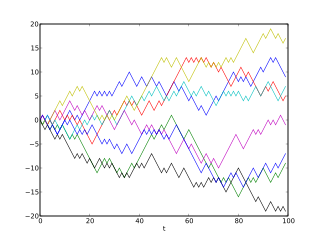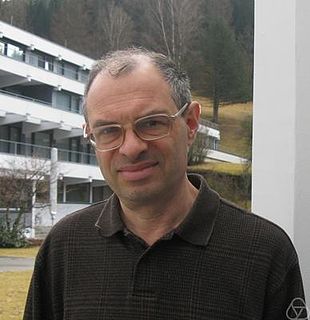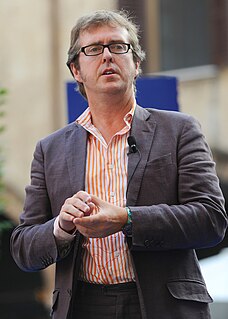Related Research Articles
The Black–Scholes or Black–Scholes–Merton model is a mathematical model for the dynamics of a financial market containing derivative investment instruments. From the partial differential equation in the model, known as the Black–Scholes equation, one can deduce the Black–Scholes formula, which gives a theoretical estimate of the price of European-style options and shows that the option has a unique price given the risk of the security and its expected return. The formula led to a boom in options trading and provided mathematical legitimacy to the activities of the Chicago Board Options Exchange and other options markets around the world. It is widely used, although often with some adjustments, by options market participants.
Financial engineering is a multidisciplinary field involving financial theory, methods of engineering, tools of mathematics and the practice of programming. It has also been defined as the application of technical methods, especially from mathematical finance and computational finance, in the practice of finance.
Financial modeling is the task of building an abstract representation of a real world financial situation. This is a mathematical model designed to represent the performance of a financial asset or portfolio of a business, project, or any other investment.

Computational finance is a branch of applied computer science that deals with problems of practical interest in finance. Some slightly different definitions are the study of data and algorithms currently used in finance and the mathematics of computer programs that realize financial models or systems.
Emanuel Derman is a South African-born academic, businessman and writer. He is best known as a quantitative analyst, and author of the book My Life as a Quant: Reflections on Physics and Finance.
The following outline is provided as an overview of and topical guide to finance:
A masters degree in quantitative finance concerns the application of mathematical methods to the solution of problems in financial economics. There are several like-titled degrees which may further focus on financial engineering, financial risk management, computational finance and/or mathematical finance.
A local volatility model, in mathematical finance and financial engineering, is one that treats volatility as a function of both the current asset level and of time . As such, a local volatility model is a generalisation of the Black–Scholes model, where the volatility is a constant.

Victor Ginzburg is a Russian American mathematician who works in representation theory and in noncommutative geometry. He is known for his contributions to geometric representation theory, especially, for his works on representations of quantum groups and Hecke algebras, and on the geometric Langlands program. He is currently a Professor of Mathematics at the University of Chicago.

Paul Wilmott is an English researcher, consultant and lecturer in quantitative finance. He is best known as the author of various academic and practitioner texts on risk and derivatives, for Wilmott magazine and Wilmott.com, a quantitative finance portal, and for his prescient warnings about the misuse of mathematics in finance.
In finance, model risk is the risk of loss resulting from using insufficiently accurate models to make decisions, originally and frequently in the context of valuing financial securities. However, model risk is more and more prevalent in activities other than financial securities valuation, such as assigning consumer credit scores, real-time probability prediction of fraudulent credit card transactions, and computing the probability of air flight passenger being a terrorist. Rebonato in 2002 defines model risk as "the risk of occurrence of a significant difference between the mark-to-model value of a complex and/or illiquid instrument, and the price at which the same instrument is revealed to have traded in the market".
A quantitative fund is an investment fund in which investment decisions are determined by numerical methods rather than by human judgment. See Quantitative analysis (finance) § Quantitative investment management.
Quantitative analysis is the use of mathematical and statistical methods in finance. Those working in the field are quantitative analysts. Quants tend to specialize in specific areas which may include derivative structuring or pricing, risk management, algorithmic trading and investment management. The occupation is similar to those in industrial mathematics in other industries. The process usually consists of searching vast databases for patterns, such as correlations among liquid assets or price-movement patterns. The resulting strategies may involve high-frequency trading.
Mathematical finance, also known as quantitative finance and financial mathematics, is a field of applied mathematics, concerned with mathematical modeling of financial markets. Generally, mathematical finance will derive and extend the mathematical or numerical models without necessarily establishing a link to financial theory, taking observed market prices as input. Mathematical consistency is required, not compatibility with economic theory. Thus, for example, while a financial economist might study the structural reasons why a company may have a certain share price, a financial mathematician may take the share price as a given, and attempt to use stochastic calculus to obtain the corresponding value of derivatives of the stock. The fundamental theorem of arbitrage-free pricing is one of the key theorems in mathematical finance, while the Black–Scholes equation and formula are amongst the key results.
Robert F. Almgren is an applied mathematician, academic, and businessman focused on market microstructure and order execution. He is the son of Princeton mathematician Frederick J. Almgren, Jr. With Neil Chriss, he wrote the seminal paper "Optimal execution of portfolio transactions," which Institutional Investor said "helped lay the groundwork for arrival-price algorithms being developed on Wall Street." In 2008 with Christian Hauff, he cofounded Quantitative Brokers, a financial technology company providing agency algorithmic execution in futures and interest rate markets. He is currently Chief Scientist at QB and a visiting professor in Operations Research and Financial Engineering at Princeton University.
Transaction cost analysis (TCA), as used by institutional investors, is defined by the Financial Times as "the study of trade prices to determine whether the trades were arranged at favourable prices – low prices for purchases and high prices for sales". It is often split into two parts – pre-trade and post-trade. Recent regulations, such as the European Markets in Financial Instruments Directive, have required institutions to achieve best execution.

Marco Avellaneda (Ph.D.) is an American mathematician and financial consultant. He is currently the director of the Division of Financial Mathematics at the Courant Institute at New York University.
In the mathematical theory of Lie groups, the Chevalley restriction theorem describes functions on a Lie algebra which are invariant under the action of a Lie group in terms of functions on a Cartan subalgebra.

WorldQuant, LLC is an international hedge fund and quantitative investment management firm headquartered in Old Greenwich, Connecticut. Founded in 2007, the firm is currently managing approximately $5 billion in assets under management for Millennium Management via quantitative trading and other methods of quantitative investing. WorldQuant operates the WorldQuant Challenge, where participants compete in the field of quantitative finance, and WorldQuant Accelerator, an independent portfolio manager platform. In 2015 the WorldQuant Foundation launched WorldQuant University.
References
- ↑ Imogen Rose-Smith, (July 20, 2011) "Neil Chriss's Multistrat Hedge Fund Puts Up The Numbers". Institutional Investor .
- ↑ "Neil Chriss biography at "Math for America" webpage". Archived from the original on 2012-04-07. Retrieved 2011-11-27.
- ↑ Institute for Advanced Study Appoints Neil Chriss to Board of Trustees
- ↑ R. Lindsay and Barry Schachter, "How I became a Quant", Wiley (2007), ISBN 978-0-470-05062-0
- ↑ Denby, Cambell, Bedeschi, Chriss, et al.,, "Neural Networks for Triggering," IEEE Tians. Nucl. Sci, 37(2) (1990), 248–254
- 1 2 "Archived copy". Archived from the original on 2012-08-01. Retrieved 2012-01-08.CS1 maint: discouraged parameter (link) CS1 maint: archived copy as title (link)
- ↑ The thesis followed up on David Kazhdan and George Lusztig, "Proof of the Deligne-Langlands conjecture for Hecke algebras", Invent. Math, 87 (1987), 153–215
- ↑ Victor Ginzburg and Neil Chriss. Representation Theory and Complex Geometry. Birkhäuser, 1997.
- ↑ I.Kani and E.Derman, "Riding on a Smile", Risk 7(2) (1994), pp. 32–39
- ↑ E. Derman, I. Kani, N. Chriss, "Implied trinomial trees of the volatility smile", Journal of Derivatives (1996)
- ↑ Jacob Wolinsky (July 9, 2012). "Exclusive: How Hutchin Hill Took Down JPMorgan". ValueWalk.
- ↑ R.Almgren and N.Chriss, "Optimal execution of portfolio transactions" J. Risk, 3 (Winter 2000/2001) pp.5–39
- ↑ The Institutional Investor magazine
- ↑ David Leinweber, "Algo vs. Algo", The Institutional Investor's Alpha, February 2007
- ↑ A TRADE Guide to Broker Algorithms, The TRADE, Issue 3, Jan–Mar 2005
- ↑ Robert Almgren and Neil Chriss, "Bidding principles" Risk, June 2003
- ↑ Robert Almgren and Neil Chriss , "Value under liquidation", Risk, Dec. 1999
- ↑ "Reuters and ICor combine for electronic derivatives". Finextra Research. Retrieved 2008-06-30.CS1 maint: discouraged parameter (link)
- ↑ "Reuters assumes full control of ICor Brokerage; targets interest rate swaps". Finextra Research. Retrieved 2008-06-30.CS1 maint: discouraged parameter (link)
- ↑ NYU Program in Mathematics in Finance
- ↑ Robert Almgren and Neil Chriss, "Optimal portfolios from ordering information", Journal of Risk, Fall 2006
- ↑ Goldenfeld, Nigel (March 2009). "Job Hunting on Wall Street". Finance for Physicists. University of Illinois. Retrieved December 9, 2011.CS1 maint: discouraged parameter (link)